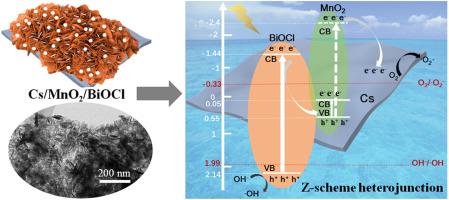Journal of Alloys and Compounds ( IF 6.2 ) Pub Date : 2021-09-24 , DOI: 10.1016/j.jallcom.2021.162090 Xiaodong Hong 1 , Yang Li 2 , Xu Wang 2 , Jiapeng Long 3 , Bing Liang 3

|
Photocatalysis is a sustainable energy conversion technology for degradation of organic pollutants, while developing high-performance photocatalysts is a major task of photocatalysis. Herein, potassium citrate-derived carbon nanosheets (Cs) are prepared and acted as sacrificial templates for preparing Cs/MnO2 nanosheets arrays, and then thin BiOCl nanosheets are deposited to fabricate Cs/MnO2/BiOCl (Cs/Mn/Bi) composite photocatalyst. Through adjusting the loading amount of BiOCl, the optimized Cs/Mn/Bi-1/1 composite exhibits the highest photocatalytic activity and excellent recycling degradation performance, which degrades 97% of Rhodamine B in 25 min, 98% of Methylene blue in 40 min, and 80% of Tetracycline hydrochloride in 30 min, and the degradation rate constant is 0.129, 0.081 and 0.038 min-1, respectively. Based on electron spin resonance result, ·O2− and ·OH radicals are the reactive species for degradation of organic pollutants, and the photocatalytic mechanism is verified as the Z-scheme transfer mode. The superior photocatalytic performance is attributed to the formation of Z-scheme heterojunction between MnO2 and BiOCl, which narrows the band gap and broadens the light absorption range. Furthermore, conductive carbon layer in composite reduces the charge transfer resistance and accelerates the separation and transfer efficiency of photogenerated carriers.
中文翻译:

用于降解有机污染物的碳纳米片/MnO2/BiOCl三元复合材料
光催化是一种用于降解有机污染物的可持续能源转换技术,而开发高性能光催化剂是光催化的主要任务。在此,制备了柠檬酸钾衍生的碳纳米片 (Cs) 并作为制备 Cs/MnO 2纳米片阵列的牺牲模板,然后沉积薄的 BiOCl 纳米片以制备 Cs/MnO 2 /BiOCl (Cs/Mn/Bi) 复合材料光触媒。通过调节BiOCl的负载量,优化后的Cs/Mn/Bi-1/1复合材料表现出最高的光催化活性和优异的回收降解性能,25 分钟降解97%的罗丹明B ,40 分钟降解98%的亚甲蓝, 和 80% 的盐酸四环素在 30 min,降解速率常数分别为 0.129、0.081 和 0.038 min -1。基于电子自旋共振结果,· O 2 -和· OH自由基是降解有机污染物的反应物种,其光催化机理被证实为Z-scheme转移模式。优异的光催化性能归因于MnO 2和BiOCl之间形成Z 型异质结,这缩小了带隙并拓宽了光吸收范围。此外,复合材料中的导电碳层降低了电荷转移阻力,加快了光生载流子的分离和转移效率。



























 京公网安备 11010802027423号
京公网安备 11010802027423号